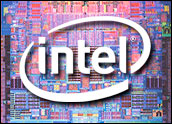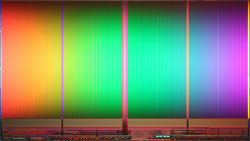
Intel and Micron have jointly announced what may be the world’ssmallest, densest NAND flash memory device yet.

Their 25-nanometer (25nm) NAND flash semiconductor offers 8 GB ofmemory in a single NAND processor. This could pave the way for higher-capacitystorage for consumer devices.
The 25nm NAND semiconductor is sampling now; it will be in productionin the second quarter of 2010.
Chip Sandwich
For consumer electronics manufacturers, the 25nn NAND processorprovides the highest density in a single two bits-per-cell multi-levelcell die that will fit an industry-standard, thin small-outlinepackage, Intel said.Multiple 8 GB processors can be stacked in a package to increasestorage capacity.
The processor measures 167 square millimeters. Put another way, itwill fit through the hole in the middle of a CD. However, it has morethan 10 times the 700 MB capacity of a CD.
The 25nm, 8 GB processors cut chip count by half compared to previousprocessors. For example, a 256 GB solid-state disk (SSD) will use 32of these processors instead of the 64 older-generation NAND flashprocessors previously required, Intel said.
The 25nm NAND flash processor is being produced by IM FlashTechnologies, a joint venture between Intel and Micron set up in 2006.
More NAND Bang for the Buck
Manufacturers of consumer devices and SSDs will leverage the 25nm NANDflash processors’ small size to cram more memory into their productsand cut prices, Carl Howe, director of anywhere research at the YankeeGroup, told TechNewsWorld.
“Most of the cost in any of these devices scales with the number ofchips, so if it takes 32 chips to create a 256 GB solid state diskinstead of 64, reliability goes up because there are fewer parts, andcost goes down,” Howe explained. “So, the capacity of solid statedisks will get lots bigger.”
Most SSD manufacturers use flash memory in their products for itsdurability and ruggedness.
Currently, flash memory is used primarily in smartphones, memorycards and USB flash drives. The technology is non-volatile, so flash memory chipsdo not require power to maintain information stored in them. Further,flash memory is very durable and can take physical shocks better thanDRAM memory.
Taking a Bite Out of Apple?
Will the new, denser NAND flash processors impact Apple? Cupertino hasmanaged to keep down costs while increasing profits by prepurchasingcomponents and leveraging economies of scale.
Apple is one of the biggest users of flash memory, gobbling it up forits iPod and iPhone. It made a US$500 million prepayment to Toshiba forflash memory chips in July — will that leave it stuck with the oldertechnology?
Not likely, Howe contended. “Apple probably has committed that preorderto production so the fact that there’s something newer and denser isinteresting data but probably doesn’t impact its six- to 12-monthplan,” he explained.
“Apple’s got more products out now, and I’d guess $500 million worth ofNAND flash will probably be one quarter’s supply,” Howe said.





















































